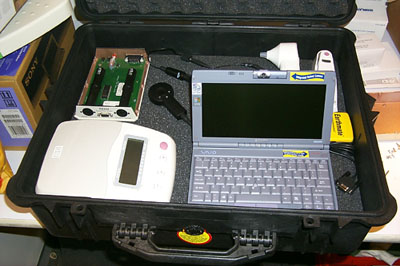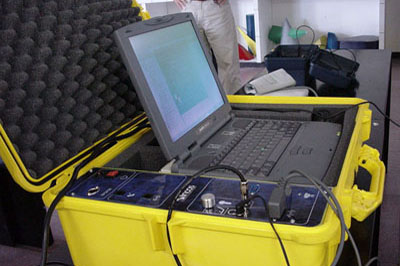![]()
Portable Tele-Diagnostic Devices
Ari Adler
Background
The MIT Media Laboratory has been working with the non-profit Costa Rica Foundation for Sustainable Development and the Instituto Tecnólgico de Costa Rica on the LINCOS (Little Intelligent Communities) project. The project has as a general goal to help introduce telecommunications, information, education, and health services into remote areas of developing nations. This is accomplished by converting used ISO shipping containers into 'digital town centers' that house a computer classroom, an information/service center, a videoconference area and a telemedicine room. One of the key aspects of this project is to identify and develop a low cost telemedicine solution that would allow local health practitioners in remote areas to perform a wide range of basic diagnostics on patients of their communities. This is the basic idea of telemedicine: to provide the tools to gather and forward patient information. This information gets sent via the Internet (in the form of text, graphics, audio and video) to a doctor in another part of the country that can perform an expert diagnosis and in turn recommend a plan of action for the patient. The first large-scale deployment of the LINCOS containers will be in the Dominican Republic, therefore there is a great opportunity to begin development of an appropriate telediagnostic unit in the very near future.

First Prototype of the LINCOS Container outside of the Media Lab, March 1999
The Problem
The major problem with existing telemedicine solutions is that they are too costly. They usually consist of highly specialized, large, sophisticated systems ranging between15 and 50 thousand dollars. These systems, although generally cost effective in the long run in developed countries are not designed for the primary care of the world's poorer nations. There is a urgent need for the development of a portable unit that can serve some of the basic functions of telemedicine, and in addition be of sufficiently low cost so as to allow it's widespread use in developing nations that cannot afford the alternatives. In addition to medical diagnostics, there appears to be a great opportunity to gather basic environmental and meteorological data from rural areas. This data is extremely useful not only to environmental and metereological institutions, but also to the health Institutions themselves because of the obvious link between health and the state of the surrounding environment.
|
Stationary, high-cost telemedicine device
|
Portable, low-cost telemedicine device
|
Research
My research involves designing and prototyping a small and relatively inexpensive (under $5k) multidiagnostic device. The system will be based on a handheld or portable computer platform, and will utilize several peripherals to do medical, environmental and metereological sensing. I am investigating the new biological and environmental sensor technologies that can lower cost and size substantially while allowing more sophisticated measurements. The basic types sensing that this device will be capable of processing are:
|
|
|
First
prototype images click
here.
|
Second
prototype images click
here.
|
 |
 |